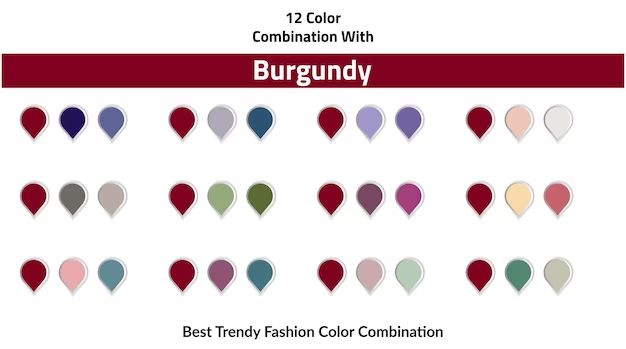Accent color refers to the use of a secondary color that contrasts with the main or neutral color palette in an outfit or fashion design. The purpose of using an accent color is to create visual interest, highlight certain elements, and add vibrancy to an otherwise subdued look.
Definition of Accent Color
In fashion design, the accent color is the color that stands out and serves as a complement to the outfit’s main neutral or foundational color scheme. For example, if the bulk of an outfit is composed of black, white, gray, tan, navy, or other neutral shades, a bright pop of red or orange would be considered the accent color.
Accent colors are used strategically to draw the eye, create focal points, and liven up neutrals like brown, beige, white, black, navy, or gray. They add spice, personality, and visual appeal. Typically, accent colors are used sparingly in accessories, footwear, jewelry, handbags, or other small details.
Purpose of Accent Colors
There are several reasons accent colors are useful in fashion:
- Make neutrals and basics more interesting – A neutral outfit can look blah without a pop of color. Accents energize it.
- Highlight parts of the body – Bright colors worn on the waist, neckline, or shoulders flatter these areas.
- Compliment skin or hair tone – Certain hues look best with particular complexions and hair colors.
- Create the illusion of proportions – Dark bottoms with light tops balances the body. Color accents can achieve this.
- Add personality – Accent colors reflect personal style and mood.
- Make a statement – Vibrant accents proclaim individuality.
By using accent colors strategically, fashion designers and style mavens can liven up outfits, flatter the wearer, and communicate personal flair.
Choosing Accent Colors
Certain guidelines can help choose accent colors that work:
- Complement skin tone – Determine whether cool or warm accent colors are more flattering.
- Match hair color – Accent with analogous shades for seamless look.
- Pair neutrals artfully – Don’t accent all black with red; maybe only red shoes.
- Use color wheel theory – Pick complementary or analogous hues.
- Consider context – Brights for daytime, jeweled tones for evening.
- Select personal colors – Choose hues that reflect style and personality.
Accenting with the right colors results in polished, put-together looks.
Some examples of commonly used accent pairings include:
| Neutral | Accent Color |
|---|---|
| Black | Red, white, emerald green |
| Gray | Yellow, pink, purple |
| Navy | Orange, light blue, coral |
| Brown | Blue, teal, pink |
| White | Black, navy, pastels |
Using these timeless pairings as starting points helps create stylish looks.
Accent Color in Fashion History
The use of accent colors in fashion has evolved through history:
- 1800s – Victorian era saw lavish use of rich, dark accent colors with black clothing.
- 1920s – Flappers chose bright hues like emerald to accent neutral robes.
- 1950s – Pastel accents like mint green polka dots contrasted with gray suits.
- 1960s – Psychedelic accents like daisy yellow or fuchsia shocked against black.
- 1970s – Warm earthy brown outfits accented with orange, mustard, rust.
- 1980s – Electric blue or neon pink trims “popped” against grays.
- 1990s – Grunge flannels featured plaid accents in greens and reds.
- Now – Vibrant athleisure wear accents neutrals in on-trend shades.
Today, accent colors remain an important styling tool for infusing visual dynamism into fashion.
Ways to Use Accent Colors
There are endless possibilities for strategically employing accent colors:
- Shoes – Heels, flats, sneakers
- Handbags – Clutches, totes, crossbody bags
- Belts – Skinny, wide, patterned
- Scarves – Silk, chunky knit
- Jewelry – Earrings, necklaces, bracelets
- Hats – Wool, felt, baseball caps
- Eyewear – Sunglasses, optical frames
- Hair accessories – Headbands, clips, elastics
- Ties – Skinny, bow ties, Ascots
- Pocket squares
- Socks
- Intimate apparel – Bras, bralettes, lingerie
- Swimwear – Bikini tops or bottoms, coverups
- Outerwear – Jackets, coats
- Dresses – Day, cocktail, evening
- Blouses – Button-downs, camisoles, tunics
- Skirts
- Trousers – Suiting, jeans, joggers
- Tops – Tanks, sweaters, tees
- Rompers & jumpsuits
Incorporating accent colors into any of these garments or accessories can spruce up an outfit.
Tips for Pulling Off Accent Colors
Follow these suggestions to nail accent color pairings:
- Start small – Add a pop of color with just one accessory like a bright red clutch.
- Echo accents – Bring the accent color into 2-3 accessories for a pulled together look.
- Limit accents – Stick to 1-2 statement accent pieces to avoid looking overdone.
- Consider scale – Larger garments like coats or dresses take brighter hues than small items like jewelry.
- Match intensity – Pair a vibrant accent with equally bold neutrals. Muted accents suit softer neutrals.
- Repeat motifs – Use an accent print or pattern on different garments to reinforce the accent color.
- Mind the event – Save extremely vivid accents for appropriate settings like parties or events.
- Be adventurous – Step outside comfort zone to discover new accent colors that work.
By thoughtfully selecting and styling accent pieces, it’s easy to put together fashion-forward looks.
Conclusion
Accent colors are a powerful styling tool for infusing visual dynamism and personal flair into fashion. Strategically choosing accent colors that complement skin tones and pair well with outfit neutrals results in polished, pulled-together looks. Using accent colors creatively on garments, accessories, or details like pocket squares makes it possible to transform drab outfits into stylish statements. With so many possibilities, accent colors are an essential technique for expressing individuality through fashion.


